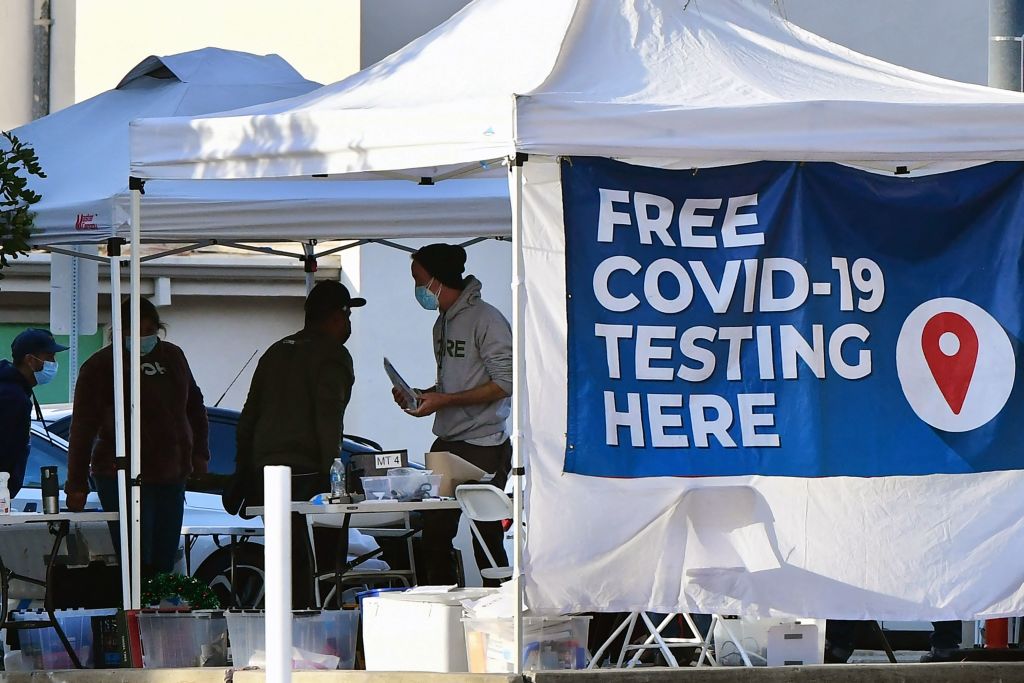Happy Friday! Embrace today with the joyful naiveté of the Miami Marlins employee who mistakenly ran onto the field yesterday, grabbed a ball that was still in play, and chucked it into the stands, allowing Mookie Betts of the Los Angeles Dodgers to score.
Quick Hits: Today’s Top Stories
- The Biden administration is weighing a move that would keep migrant families detained crossing into the United States illegally close to the border in Texas while their asylum claims are processed, the Los Angeles Times reported Thursday. Such a “remain-in-Texas” policy could aid authorities in deporting families that don’t qualify for asylum, but would likely face stiff opposition from border states and immigrant advocacy groups. The U.S. Border Patrol arrested 91,000 migrants who crossed the border in a family group in August—the highest monthly record to date.
- German Rivera—one of the conspirators charged in the 2021 assassination of Haitian President Jovenel Moïse—pleaded guilty in federal court in Florida on Thursday to aiding and supporting the plot. Rivera—a retired Colombian army colonel—had previously pleaded not guilty after he was extradited to the U.S. this year, but is now cooperating with prosecutors still trying to get to the bottom of the plot. Rivera is one of 11 defendants in the case—one other defendant has pleaded guilty so far and was sentenced to life in prison earlier this year.
- The U.S. is shifting some troops and equipment out of an American air base near the Nigerien capital of Niamey and to another base in central Niger following the country’s military takeover in July, Pentagon officials said yesterday. According to a spokesperson, the move was made “out of an abundance of caution” and there was no threat of violence. A small number of non-essential personnel will withdraw from the country—there are currently 1,100 American troops in Niger. France maintains 1,500 troops in the country and is currently in talks with Niger’s junta about removing their military presence.
- President Joe Biden announced on Thursday his intent to nominate Michael Whitaker to serve as the head of the Federal Aviation Administration. Whitaker is currently an executive at Supernal—a Hyundai company working on an electric aircraft—and previously served as deputy FAA administrator in the Obama administration. The nomination comes amid an increase in safety incidents and near misses between commercial planes.
- Peter Navarro—a trade adviser to former President Donald Trump—was found guilty of criminal contempt of Congress yesterday for refusing to testify before the House January 6 Committee. He is the second Trump aide or confidant to be convicted of contempt for not complying with a subpoena from the select committee. Steve Bannon was sentenced to four months in jail and a $6,500 fine last October, and is currently appealing the conviction. Navarro is scheduled to be sentenced on January 12.
A COVID-19 Uptick

It’s been 316 days since we last devoted a full edition of TMD to an update on COVID-19 in the United States. Today, the clock restarts.
For many of us, daily concern about COVID-19 faded from our lives long ago. But, there are indications the virus is making a comeback. Here at The Dispatch, Declan Garvey was our canary in a coal mine, going down for the count with the virus in early August (but still managing to host Dispatch Live, muting himself every time he had to cough). For the general public, another anecdotal sign came on Monday evening, when first lady Jill Biden tested positive for the virus. It’s her second go-round (or third, if you count “rebound” cases), after she and President Joe Biden contracted COVID-19 late last summer.
The virus does indeed seem to be on the rise again, though the infrastructure we once used to track such surges has been largely dismantled. New Omicron subvariants—EG.5 and the ascendant BA.2.86—don’t appear to be more severe than the XBB.1.5 subvariant that drove infections in the spring, but they may be better able to infect people who otherwise had some immunity to the virus, either from contracting COVID-19 itself or from being vaccinated and boosted. Vaccine manufacturers say their newest booster protects against the latest strains in circulation, but if past is prologue, not many people are going to get the shot. Even if case counts continue their upward trajectory, however, don’t hold your breath waiting for shutdowns or mask mandates to return.
Although data on new infections has gotten spottier, metrics from the Centers for Disease Control and Prevention (CDC) are largely still usable for severe cases—and they indicate new COVID-19 hospitalizations are up almost 16 percent nationally week-over-week. New weekly hospitalizations had fallen every single week since January, until the trend began to reverse in early July.
Annual data, however, tell a far more uplifting story. According to the CDC, 17,418 people were admitted to the hospital with COVID-19 in the week that ended on August 26, down from 36,922 during roughly the same week last year. Looking at the same span in 2021, a whopping 85,785 people were admitted with COVID-19. At the figure’s high point in January 2022, 150,674 people were admitted—more than eight times the current figure. “Those who get hospitalized—it appears to be those who are at greatest risk, meaning unvaccinated, or over 75, have multiple comorbidities, health problems, or are immunocompromised or pregnant,” says Dr. Paul Offit, a member of the Food and Drug Administration Vaccines and Related Biological Products Advisory Committee and director of the Vaccine Education Center at the Children’s Hospital of Philadelphia.
Deaths from COVID-19—a lagging indicator when it comes to tracking the virus’ spread—have also begun to tick up, but are still extremely low relative to just about any other period of the pandemic. In the week ending on August 19, according to the CDC, 722 people died of COVID-19 in the U.S.—down from 3,166 during a similar period in 2022, and 12,181 roughly a year before that. “It’s an increase,” Offit tells TMD. “But because it’s increasing over a very small number, it’s still a very small number.”
Such an end-of-summer surge isn’t unexpected based on more than three years of COVID-19 experience, Dr. Chris Beyrer, an epidemiologist and the director of Duke University’s Global Health Institute, tells TMD: “I think what we’ve seen for the last several years is that it’s this time of year—August, September, maybe starting in July—when people are coming back to school, when universities are reopening, when all of that population mixing is happening that we’ve typically had COVID surges.”
Wastewater testing—which detects the presence of the virus in human stool—is still a useful method of monitoring the virus’ spread, especially in discrete but dense populations like college campuses. That metric, too, is showing rising levels of COVID-19 in the country.
Hospitalizations and deaths are two of the remaining ways the U.S. is tracking COVID-19 at the individual level, as pandemic-era reporting infrastructure has more or less closed up shop. On May 11, Biden allowed the COVID-19 Public Health Emergency to expire, which rolled back temporary expansions to Medicaid, ended the Title 42 immigration policy, and changed the source of some COVID-19 reporting at the CDC. “I thought in advance of this [interview], I should go and look at the Hopkins tracker,” says Beyrer, who spent much of his career at Johns Hopkins University. “And we stopped reporting months ago.” Johns Hopkins’ comprehensive COVID-19 dashboard—which recorded raw data globally and helped this newsletter provide daily updates on case counts for more than a year—stopped updating in March of this year.
If you’re testing positive these days, it’s likely you have one of several Omicron subvariants—XBB.1.5, which drove infections earlier this year; EG.5, currently the dominant variant in the U.S.; or BA.2.86, which is on the rise. “The bad news is this virus does continue to evolve away from [the] protection against mild disease” offered by vaccines and previous exposure to COVID-19, Offit says. The good news, he adds, is that vaccination and/or a previous bout of COVID-19 are still quite effective at protecting against severe infections. “The goal is not to prevent mild illness,” Offit says. “You’ll get mild illness with this virus for decades to come, if not longer. But that’s okay.”
COVID-19 vaccine development is increasingly adopting a flu-style regime, where shots are targeted at specific strains expected to be dominant in the winter months, when people stay inside and disease is more likely to spread. Vaccine manufacturers Moderna and Pfizer recently reported that their new booster—likely to be in pharmacies by late September—is effective against all three of those previously mentioned strains, even though it was formulated specifically to provide protection against XBB.1.5. The flu model is imperfect, Offit says, because of the high baseline of lingering immunity people have to COVID-19 after having the virus or being vaccinated. That protection isn’t necessarily present from year-to-year with influenza, which makes it even more imperative the FDA picks the correct flu strain to target every year. The CDC estimates the 2018-2019 flu season—the last before the discovery of COVID-19—caused between 531,000 and 647,000 hospitalizations and 36,400 and 61,200 deaths.
More than three-and-a-half years after the COVID-19 reached the United States’ shores, the two experts agree the country’s grasp on the virus is encouraging overall. Paxlovid and other antiviral medications are effective treatments, especially for those at high risk of severe illness, and therapeutics and hospital management related to the disease are constantly improving. People who have been infected should still take precautions, particularly around those who are immunocompromised, but it’s unlikely the country will see pandemic-era restrictions and mandates make a comeback this fall. “The idea that with the current levels of hospitalizations and loss of life that we, for example, are going to close public schools again, or mandate masking again, I think that that is not warranted by the current epidemiology,” Beyrer tells TMD.
Offit agrees. “It looks like we’ve gotten on top of this pandemic,” he says. “If you define ‘pandemic’ as a virus that changes the way that you live, work or play, I think people are for the most part back to normal.”
Worth Your Time
- For years, the nationalization of politics has eroded the diversity of state and local Republican parties. But some Republican lawmakers are trying to reverse the trend. “In recent years, county parties have censured Republican officeholders for not toeing the national party line on Medicaid expansion, pandemic restrictions and Donald Trump,” Stephanie Muravchik and Jon Shields write for the New York Times. “We have spent the past couple of years studying the Republican Party in Wyoming, where we have observed this clash between the nationalizers and the traditional Republicans up close,” the pair write. “The party’s old heads have made it a priority to defend what they call the Wyoming way, which includes keeping national issues of little relevance to Wyomingites out of state politics, however important they might be elsewhere. … Already, you can see how a fully nationalized politics might backfire on Republicans. It creates a false sense of what the state governments can actually achieve. Even if there is a border crisis, for example, the State of Wyoming can’t do much about it. As Landon Brown, an establishment Republican in the State Legislature told us, ‘We have spent more time debating a nonissue than fixing our state budget issue.’ And as Cathy Connolly, a former House minority leader, noted, ‘There is no solution to a nonproblem.’ Whipping up people’s passions may be galvanizing for now, but at some point, people will realize that their government hasn’t done anything to improve their day-to-day lives.”
Presented Without Comment
New York Times: In Escalation, [Mayor Eric] Adams Says Migrant Crisis ‘Will Destroy New York City’
Also Presented Without Comment
Associated Press: China Authorities Arrest 2 For Smashing Shortcut Through Great Wall with Excavator
Toeing the Company Line
- In the newsletters: Mike breaks down the latest polling on the legal cases against Trump and Nick argues Mike Pence’s “Time for Choosing” speech is too little, and much too late.
- On the podcasts: Steve, Jonah, and Chris join Mike to discuss the seemingly inevitable Trump v. Biden rematch on the Dispatch Podcast.
- On the site today: Audrey recaps her time with Vivek Ramaswamy on the campaign trail in New Hampshire.
Let Us Know
What are your predictions for the (now underway!) NFL season?







Please note that we at The Dispatch hold ourselves, our work, and our commenters to a higher standard than other places on the internet. We welcome comments that foster genuine debate or discussion—including comments critical of us or our work—but responses that include ad hominem attacks on fellow Dispatch members or are intended to stoke fear and anger may be moderated.
With your membership, you only have the ability to comment on The Morning Dispatch articles. Consider upgrading to join the conversation everywhere.